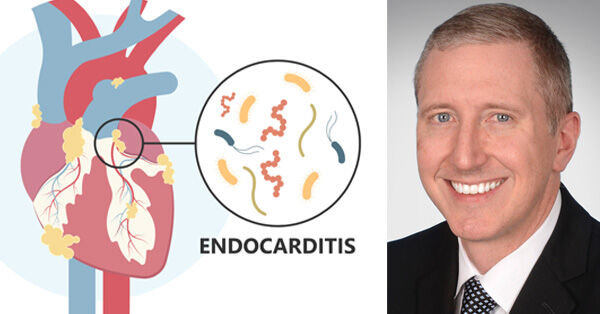Endocarditis: Top 7 Facts People Should Know
Written By: Adam Pick, Patient Advocate & Author
Medical Expert: David Kaczorowski, MD, Surgical Director of the UPMC Heart Transplant Program
Published: August 16, 2022
Endocarditis is a rare, but life-threatening condition that occurs when an infection in the bloodstream spreads to the heart. If left untreated, this condition can seriously damage or destroy your heart valves.

Understanding the symptoms and treatment for endocarditis is essential in caring for your heart and prioritizing a healthy lifestyle. We met with David Kaczorowski, MD, surgical director of the UPMC Heart Transplant Program to learn more about this condition.
Fact 1: What causes endocarditis?
Endocarditis, also known as infective endocarditis (IE), begins when a bacterial infection enters the bloodstream and spreads throughout the body, eventually reaching your heart. These bacteria can come from any injury to the skin that may be infected, or from several conditions related to oral hygiene, including gingivitis, dental infections, or injuries to your mouth or gums.
Once the bacteria reach your heart, they attach to the lining of your heart and cause inflammation, which is why those with heart defects or damaged heart valves are at the highest risk of endocarditis.
Fact 2: Can this condition damage your body and your heart valves?
Yes. Although endocarditis is more dangerous to patients with heart defects or heart damage, it can still cause harm to a healthy individual.
Patients with infective endocarditis are at an increased risk for stroke or heart attacks, as this condition can block your arteries and cause blood clots. Or, if your heart valve becomes infected and inflamed due to endocarditis, pieces can break loose and spread throughout your body. When these fragments, known as emboli, spread to your organs, they can be extremely dangerous to your health.
Fact 3: What are common symptoms of endocarditis for heart valve patients?
There are two types of endocarditis, and each affects your body differently. Acute bacterial endocarditis quickly takes a toll on the body and results in major damage to the heart valves. If you experience symptoms such as fatigue, high fever, or a rapid heart rate, seek medical attention right away to minimize the damage to your heart.
The second form of endocarditis is subacute bacterial endocarditis, or chronic IE. This affects your body over an extended period of time and can span over months. Chronic IE causes very mild symptoms, including:
- Fatigue
- Sweating
- Mild fever
- Moderately fast heart rate
- Weight loss
- Low red blood cell count
These symptoms are often overlooked, as they can be commonly mistaken for other illnesses. If these symptoms persist, talk to your doctor to determine the exact cause.
As you monitor your health, other signs to be cautious of include painful nodules under the skin, stomach pain, blood in your urine, reddish spots on your skin, and an enlarged spleen that is tender to the touch.
Fact 4: What is the diagnosis process?
Your doctor will examine your symptoms and health history, as well as perform diagnostic tests, including a blood culture. There are additional tests that your doctor may order to examine how your heart is functioning.
One of these diagnostic tests includes a transthoracic echocardiography. This allows your doctor to monitor your heart by placing an ultrasound probe on your chest. If further testing is needed to examine your heart functionality, your doctor may use a transesophageal echocardiography or computed tomography (CT) scan, which provides them with additional images of your heart. Based on the test results, they will work with you to determine a treatment plan for your condition.
Fact 5: What are the treatment options for this condition?
Once you experience the symptoms of endocarditis, it’s critical to receive medical care as soon as possible. Your doctor will provide quick treatment to minimize the damage and prevent serious complications.
There are several treatment options that your doctor may administer to treat endocarditis. Antibiotics are a common medicine for this disease that is administered intravenously. They will likely give you this therapy in a hospital for an extended time to closely monitor your health and ensure the treatment is effective.
If untreated, endocarditis may cause serious harm to your heart valves. Depending on the severity of the damage, your doctor may order heart surgery to restore or replace the heart valves that were affected by endocarditis.
Fact 6: Are heart valve patients at risk for developing endocarditis?
This condition can affect anyone, however, those with pre-existing heart conditions are most susceptible to the extensive damage that endocarditis can cause. If you have an acquired valve disease, artificial heart valve, congenital heart disease, or have a history of valvular disease, monitoring your health for endocarditis symptoms is especially important.
If you are 60 or older, male, or immunocompromised, you have a higher risk of developing endocarditis. You can meet with your doctor to discuss preventative measures and create a plan that prioritizes your heart health.
Fact 7: Is this condition preventable?
You can take preventative measures to help lower your risk for endocarditis. One of the most effective ways to prevent endocarditis is to care for your oral health by regularly practicing good oral hygiene. Often, endocarditis is caused by daily exposure to bacteria, and caring for your gums and mouth is an effective way to avoid it.
If you are at a higher risk for developing endocarditis, your doctor may prescribe preventative antibiotics before dental or respiratory procedures. The American Heart Association recommends using antibiotic prophylaxis in few circumstances for patients with heart valve disease. It’s important to discuss your conditions with your doctor so they can prescribe you the most effective treatment option.
To learn more, visit UPMC.com/HVI.





